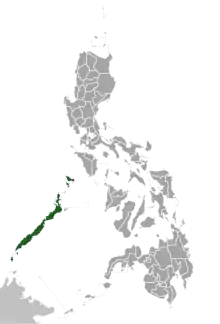Palawan hornbill
The Palawan hornbill (Anthracoceros marchei), known as Talusi in the Philippine language Cuyunon, is a largish (approximately 70 centimetres (28 in) long, weighing 750 grams (26 oz), more than 92% of bird species) forest-dwelling bird. Its plumage is predominantly black, with a white tail, a dark green gloss on its upper parts and a large creamy-white beak with a casque typical of the hornbill family. It emits loud calls which can be transcribed as kaaww and kreik-kreik.
| Palawan hornbill | |
|---|---|
 | |
| Scientific classification | |
| Kingdom: | Animalia |
| Phylum: | Chordata |
| Class: | Aves |
| Order: | Bucerotiformes |
| Family: | Bucerotidae |
| Genus: | Anthracoceros |
| Species: | A. marchei |
| Binomial name | |
| Anthracoceros marchei Oustalet, 1885 | |
 | |
| Palawan hornbill range | |
Nine species of hornbill are found in the Philippines, and the Palawan hornbill is endemic to Palawan island, but has also been recorded on the nearby islands of Balabac, Busuanga, Calauit, Culion and Coron. Most visiting birdwatchers travel to St Paul's National Park, Palawan, to see this bird, but it is now uncommon. It acts as a bio-indicator due to its sensitivity to environmental changes. It is officially classified as "vulnerable", and its numbers have reduced by at least 20% in the last 10 years due to habitat destruction, hunting for food, and the live bird trade.
The Palawan hornbill consumes mostly fruit, but also occasional insects and vertebrates. Due to its large size and home range, it is an important vector of seed dispersal for large-seeded trees. Many ground-dwelling seed-eating mammals live beneath such trees, and in areas where hornbills have become rare, consume such a large percentage of the fallen seeds that they threaten the trees' survival.[2][3]
It is usually seen in pairs or small noisy family groups, and it has a communal roosting site. It is most usually observed in fruiting trees at the forest edge, but also feeds on insects and small reptiles.
References
- BirdLife International (2012). "Anthracoceros marchei". IUCN Red List of Threatened Species. 2012. Retrieved 26 November 2013.CS1 maint: ref=harv (link)
- SEKERCIOGLU, C (August 2006). "Increasing awareness of avian ecological function". Trends in Ecology & Evolution. 21 (8): 464–471. doi:10.1016/j.tree.2006.05.007.
- Hamann, Andreas; Curio, Eberhard (August 1999). "Interactions among Frugivores and Fleshy Fruit Trees in a Philippine Submontane Rainforest". Conservation Biology. 13 (4): 766–773. doi:10.1046/j.1523-1739.1999.97420.x.
